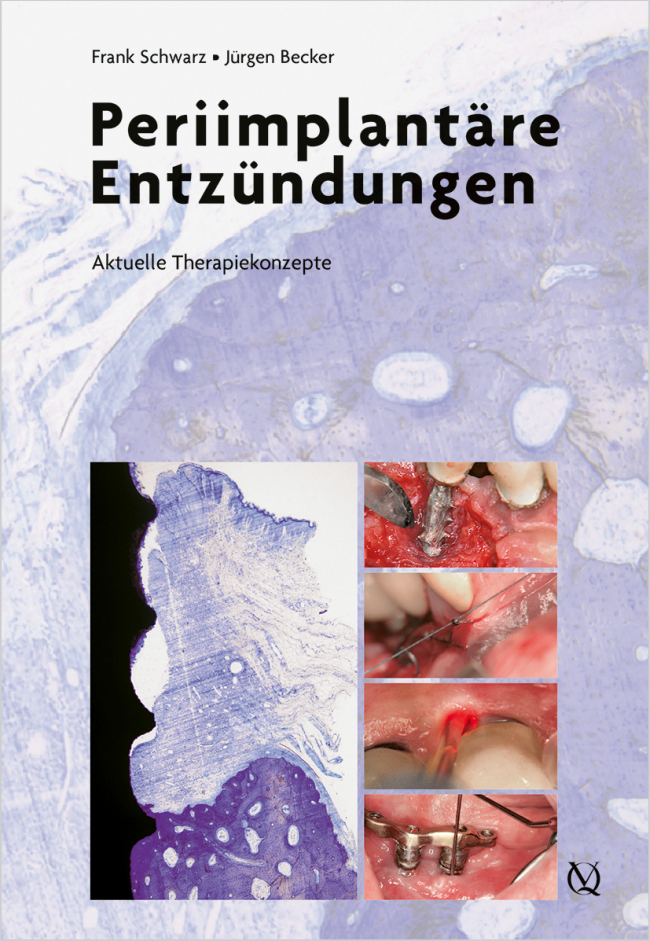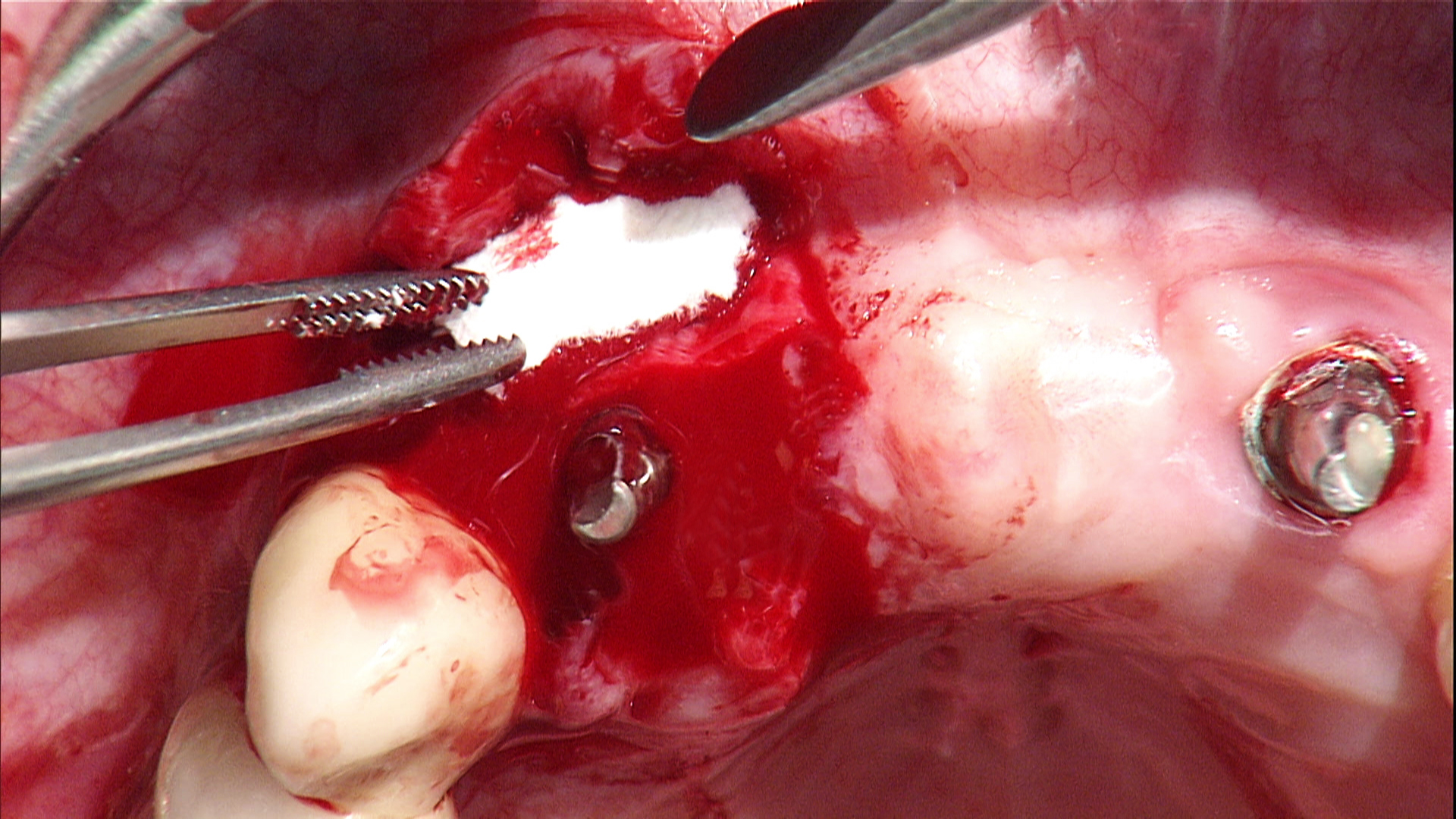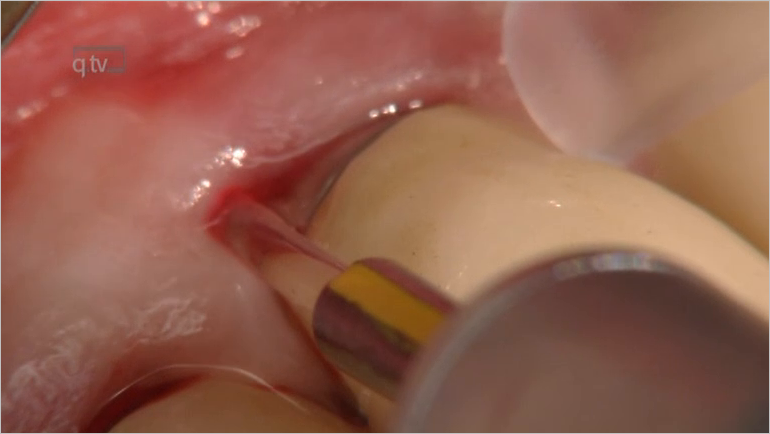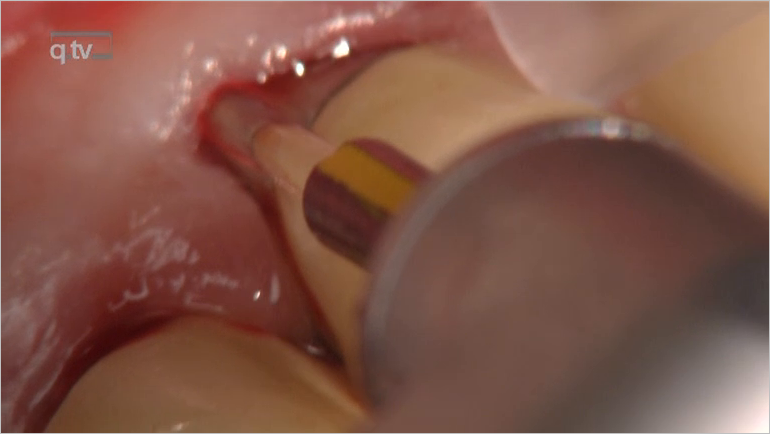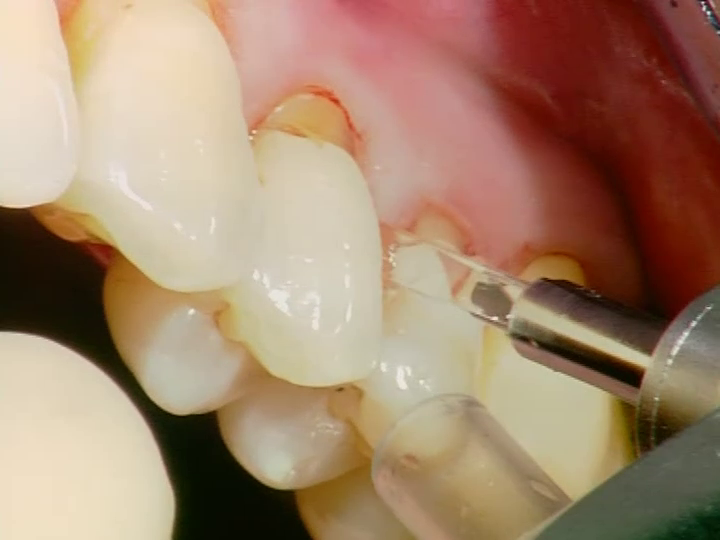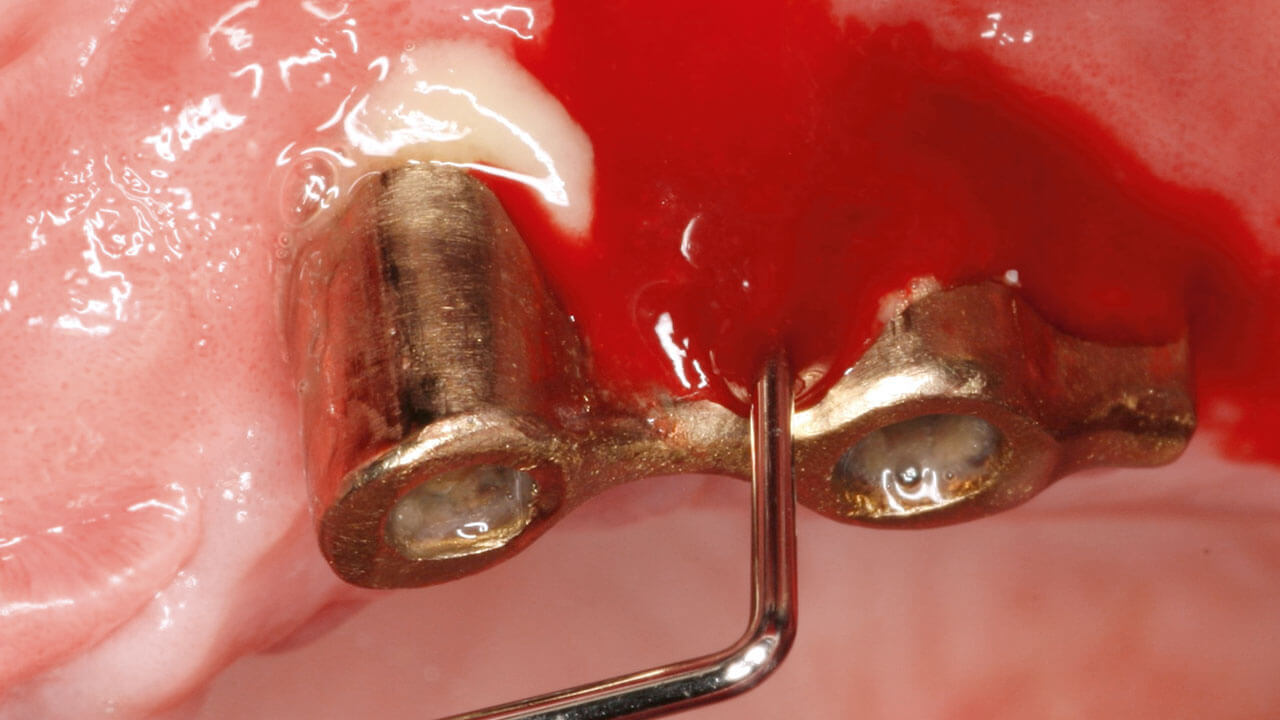Implantologie, 2/2025
Seiten: 119, Sprache: DeutschSchwarz, FrankImplantologie, 2/2025
Seiten: 173-187, Sprache: DeutschKallab, Sandra / Oberja, Karina / Schwarz, Frank / Parvini, PuriaEine Therapiemethode bei Verlust bleibender Frontzähne bei Kindern und Jugendlichen zur Erhaltung von Hart- und Weichgewebe Die Autotransplantation von Zähnen, insbesondere von Milcheckzähnen, stellt eine vielversprechende Therapieoption dar, um Zahnverluste bei Kindern und Jugendlichen zu behandeln. Dieser Fallbericht beschreibt die Therapie eines 8-jährigen Patienten, der nach einem Frontzahntrauma mit der Autotransplantation eines Milcheckzahns behandelt werden konnte. Dargestellt wird das Vorgehen von der präoperativen Planung, über die chirurgische Technik, einschließlich der Verwendung von 3D-Replikaten für eine präzise Positionierung des transplantierten Zahns, bis hin zu den postoperativen Verhaltensregeln. Der Fall zeigt eine erfolgreiche autologe Transplantation mit guter Prognose und betont die Bedeutung dieser Methode als vorbereitende Maßnahme für weiterführende definitive Behandlungen im späteren Patientenalter. Die Autotransplantation von Milchzähnen bietet eine Vorgehensweise, die sowohl ästhetische als auch funktionelle Aspekte berücksichtigt und eine minimalinvasive Option für den Ersatz fehlender Zähne im Wachstum darstellt.
Schlagwörter: Milcheckzahntransplantation, dentales Trauma, autogene Transplantation, 3D-Replikat
International Journal of Oral Implantology, 2/2025
Seiten: 135-144, Sprache: EnglischGiulini, Mika / Kassem, Nizar / Schwarz, Frank / Weigl, Paul / Schwiertz, Andreas / Sader, Robert / Lorenz, JonasPurpose: Ceramic implants are gradually becoming an alternative to standard titanium implants; however, there is still a lack of scientific data on the former. Thus, the present study was conducted to assess the clinical and microbiological performance of a two-piece ceramic implant system after a mean follow-up period of 2 years. Materials and methods: A total of 17 patients from a collective of 21 from a private dental practice that met the inclusion criteria received 32 two-piece ceramic implants (CERALOG, BioHorizons Camlog, Basel, Switzerland). The implants were restored with single crowns or three-unit fixed partial dentures. Implant survival, probing pocket depth, bleeding on probing, mucosal recession/creeping, keratinised mucosa width, Papilla Presence Index, peri-implant marginal bone level and microbiological contamination were evaluated after a mean loading period of 24 months (range 12 to 41 months). Results: All implants survived and were suitable for retaining prostheses. Probing pocket depth of 3.7 mm ± 0.7 mm and bleeding on probing on 84% of implants were recorded. Sufficient keratinised mucosa width (6.6 ± 2.9 mm) was observed with no mucosal recession/creeping. The Papilla Presence Index varied between 0 and 4 with a mean value of 1.70 ± 1.07. Mean marginal bone loss was 1.2 ± 0.9 mm. Microbiological investigation revealed no statistically significant difference in the total number of bacteria between teeth and implants (P = 0.2278); however, probing pocket depth > 4 mm proved to be a significant predictor for an increased number of bacteria (P 0.001). Conclusion: Within the limitations of the present study, the investigated two-piece ceramic implant system achieved fully satisfying functional and microbiological results. Interpretation of the clinical, radiographic and microbiological results cannot support the hypothesis that ceramic implants are less affected by peri-implant disease.
Schlagwörter: ceramic implants, microbiological test, two-piece ceramic implants, zirconia implants
The authors declare there are no conflicts of interest relating to this study.
The International Journal of Prosthodontics, 1/2025
DOI: 10.11607/ijp.8719, PubMed-ID: 38408133Seiten: 27-34, Sprache: EnglischLorenz, Jonas / Blume, Maximilian / Schwarz, Frank / Weigl, Paul / Ghanaati, Shahram / Sader, Rober A.Purpose: To investigate the effect of immediate provisionalization of single-tooth implants at healed sites for peri-implant soft-tissue conditions, focusing on papilla formation around single implants. Materials and Methods: In total, 12 patients received a total of 12 implants in the incisor, canine, or premolar region of the maxilla or mandible at healed sites with immediate chairside provisionalization. After 4 months, the temporary crown was replaced with the permanent crown. After 40 ± 13.1 months, clinical follow-up was conducted, assessing probing pocket depth (PPD), bleeding on probing (BoP), mucosal recession (MR), and width of keratinized mucosa (KM). Papilla index (PI) was determined immediately after implant placement (t0), before removing the temporary crown (t1), 4 weeks after delivery of the definitive crown (t2), and at the final follow-up examination (t3) to evaluate papilla formation and its change over time. Results: None of the implants were lost. The mean PPD was 2.5 ± 0.39 mm, and BoP of 25% and 3.5 mm of KM were observed at the final follow-up. No implants showed MR. PI increased in all patients from 1.5 ± 0.45 at t0 to 2.4 ± 0.56 at t1, 2.6 ± 0.47 at t2, and 3.0 ± 0 at t3. The increase in PI between t0 and each individual timepoint from t1 to t3 showed statistical significance. Conclusions: The present results indicate the suitability and benefit of immediate provisionalization to achieve favorable peri-implant soft tissue conditions and papilla formation.
Implantologie, 4/2024
Seiten: 433-446, Sprache: DeutschKallab, Sandra / Obreja, Karina / Schwarz, Frank / Parvini, PuriaEine LiteraturübersichtDie moderne Zahnmedizin strebt nach effizienten und ästhetisch ansprechenden Lösungen für den Ersatz fehlender Zähne. Gerade im Frontzahnbereich spielt hierbei die Sofortimplantation eine entscheidende Rolle und bietet sich als vielversprechende Methode zur raschen Versorgung an. Hierbei sollten Risikofaktoren sorgfältig analysiert werden, um optimale Behandlungserfolge zu erzielen. Trotz vergleichbarer Überlebensraten zwischen konventionell inserierten Implantaten und Sofortimplantationen sollten insbesondere mögliche ästhetische Komplikationen berücksichtigt werden, die eine präzise Diagnostik und Umsetzung durch erfahrene Behandler essenziell machen. In diesem Beitrag soll unter Berücksichtigung der aktuell verfügbaren Literatur zum Thema Sofortimplantation eine zusammenfassende Darstellung erfolgen.
Schlagwörter: Sofortimplantation, Sofortversorgung, Weichgewebemanagment, Ästhetik
International Journal of Periodontics & Restorative Dentistry, 4/2024
DOI: 10.11607/prd.6756, PubMed-ID: 37655972Seiten: 466-476, Sprache: EnglischBianchini, Marco Aurélio / Kuhlkamp, Lucas de Freitas / Schwarz, Frank / Galarraga-Vinueza, Maria ElisaDiverse surgical approaches, such as resective, reconstructive, and combined therapy, have been proposed for peri-implantitis treatment. A resective surgical approach with an adjunctive modified implantoplasty refers to the modification of the implant body into a constricted area to mimic a “waist” silhouette. This modified technique forms an adequate concave smooth area that may favor the outcomes of resective surgical therapy for soft tissue adaptation, biofilm control, and possible peri-implant bone gain over the long term. The present case series aimed to exhibit the long-term clinical and radiographic outcomes of resective surgery with adjunctive implantoplasty over a 6- to 11-year follow-up. Four patients presenting four implants (one per patient) diagnosed with peri-implantitis (according to an established case definition) were included in the present case series. Patients underwent resective surgery, a modified implantoplasty approach, and implant surface decontamination. After surgical therapy, clinical and radiographic outcomes such as bleeding on probing (BoP), suppuration on probing (SoP), probing depth (PD), marginal recession (MR), modified plaque index (mPI), and marginal bone levels (MBLs) were recorded over a long-term follow-up period. Over the 6- to 11-year follow-up, mean BoP, PD, and SoP scores amounted to 17% ± 24%, 3.2 ± 0.66 mm, and 0%, respectively. Mean BoP, PD, and SoP scores were reduced by 67% ± 24%, 2.5 ± 1.26 mm, and 100%, respectively. Radiographic analysis revealed a mean radiographic bone gain of 3.1 ± 1.84 mm. Peri-implant marginal bone loss surface area decreased by 5.7 ± 3.77 mm2 over the long-term follow-up. Resective therapy with adjunctive implantoplasty promoted favorable clinical and radiographic outcomes at treated peri-implantitis sites over a long-term period.
Implantologie, 3/2024
Seiten: 303-320, Sprache: DeutschParvini, Puria / Kallab, Sandra / Obreja, Karina / Peter, Thorsten / Trimpou, Georgia / Schwarz, FrankEin FallberichtDie Mundgesundheit der Menschen hat sich dank Fortschritten in der zahnärztlichen Rehabilitation weltweit verbessert, dies spiegelt sich in der Anzahl an zahnlosen Senioren wider. Für den zahnlosen Kiefer stehen verschiedene Therapiemöglichkeiten zur Verfügung. Implantatgestützter Zahnersatz bietet eine effektive Lösung und führt zu einer verbesserten Lebensqualität der Patienten. Anatomische Herausforderungen und die Qualität des Alveolarknochens beeinflussen den Erfolg dieser Behandlungsoptionen jedoch erheblich. Eine präzise Planung und enge Zusammenarbeit zwischen Behandler, Zahntechniker und Patienten, unter Berücksichtigung der genannten Faktoren, sind für den langfristigen Erfolg der zahnärztlichen Rehabilitation von zahnlosen oder teilbezahnten Patienten essenziell. Im Folgenden soll ein Fallbeispiel einer zahnlosen Patientin ausführlich dargestellt werden.
Schlagwörter: zahnloser Kiefer, anatomische Strukturen, Implantatanzahl, Knochenaugmentation
The International Journal of Prosthodontics, 2/2024
Open AccessDOI: 10.11607/ijp.8750, PubMed-ID: 37988432Seiten: 124-134, Sprache: EnglischRamanauskaite, Ausra / Schwarz, FrankPeri-implant diseases are defined as bacterial plaque-induced inflammatory conditions affecting implant-surrounding tissues and are classified as peri-implant mucositis and peri-implantitis. Peri-implant mucositis is characterized by an inflammatory lesion that resides in the soft tissue compartment, whereas at peri-implantitis sites the lesions also feature progressive loss of implant-supporting bone. Inflammation resolution and disease progression arrestment are the main therapeutic endpoints of the treatment of peri-implant diseases. The present position paper displays the current evidence and clinical recommendations of the European Association for Osseointegration for the treatment of peri-implant diseases. Mechanical biofilm removal along with the reinforcement of patient-administered oral hygiene is considered the standard treatment for managing peri-implant mucositis. It is recommended to assess the outcomes of peri-implant mucositis treatment 2 to 3 months after therapy, and repeated intervention should be considered in the absence of treatment success. Peri-implantitis treatment should follow a stepwise treatment approach, starting with nonsurgical treatment followed by surgical intervention, if that is not sufficient. Surgical peri-implantitis therapies include nonreconstructive, reconstructive, and combined treatment modalities. Implantoplasty may be advocated for the treatment of supracrestal peri-implant defects, whereas reconstructive therapy is indicated at peri-implantitis sites featuring intraosseous defects with a depth ≥ 3 mm. Adjunctive reconstructive measures may be beneficial in enhancing radiographic defect fill and maintaining postoperative soft tissue levels, which may have a great impact in esthetic cases. The adjunctive use of systemic antibiotics during surgical therapy does not seem to improve the clinical outcomes. Regular supportive peri-implant therapy with biofilm removal should be an integral part of the treatment protocol for peri-implant diseases. In the presence of advanced bone loss around implants that do not play a strategic role in masticatory function, implant removal may be considered immediately.
Implantologie, 2/2024
Seiten: 127, Sprache: DeutschSchwarz, FrankImplantologie, 3/2023
Seiten: 257-266, Sprache: DeutschKallab, Sandra / Schwarz, Frank / Becker, Jürgen / Brunello, GiuliaImplantate aus Zirkoniumdioxid erweisen sich als vielversprechende Alternative zu herkömmlichen Titanimplantaten. Eine 9-Jahres-Follow-up-Nachuntersuchung einer prospektiven klinischen Beobachtungsstudie dieser Arbeitsgruppe liefert weitere Daten zum Langzeiterfolg von Zirkoniumdioxid-Implantaten, welche in diesem Beitrag unter Bewertung der aktuell verfügbaren Literatur zusammenfassend dargestellt werden sollen.
Manuskripteingang: 15.08.2023, Annahme: 22.08.2023
Schlagwörter: Zirkoniumdioxid-Implantate, Langzeitstudien, Titanimplantate, periimplantäre Mukositis, Periimplantitis




